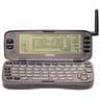Nokia 9000il Nokia 9000il User Guide in English - Page 55
application see Telephone: Tele
 |
View all Nokia 9000il manuals
Add to My Manuals
Save this manual to your list of manuals |
Page 55 highlights
7-4 Custom - When a data call is established, the modem is first set to the factory defaults and then initialized according to the string you enter here. For Terminal connections, see "Define Terminal connections" on page 7-18. Data call restrictions - Initiates a data call restrictions dialog, similar to that in the Telephone application (see Chapter 4 "Telephone: Telephone settings - Voice call forward, call restrictions and call waiting" on page 4-2). To see the current restriction mode, press Get status. To cancel all restrictions, press Cancel data restrictions. Internet access - Lists the defined Internet access points. You can define individual settings for each Internet access point. If there are no defined access points, you will not be able to connect to the Internet. Press New to define a new access point. Press Edit to change the settings of an existing access point. Press Delete to remove an access point. The Internet access settings are: Provider name - The Internet service provider's name which appears on the access point list. Phone number - Telephone number of the Internet access point. User name - Used in the PPP authentication process if required by the Internet service provider. Prompt password: Yes / No (default) - If you must enter a new password every time you log on to a server, or you do not want to save the password, change this setting to Yes. Password - Used in the PPP authentication process if required by the Internet service provider. Advanced settings - Opens a new view where you can make further adjustments for a specific Internet access point, if required: Modem initialization - Enter any modem initialization string containing AT commands here, if needed. This initialization string is executed after the initialization string you define in the Internet settings. Login customization - None (default), Manual. Some Internet access points do not automatically enable PPP. In such cases you need to choose either Manual, as it allows you to enter manually your login name and password over a terminal connection, or press New in the pop-up box, to write and save a new login script. If you choose None, your password and user name are automatically taken from the Internet access point settings. For more information on login scripts, see the scripts.txt file on the diskette supplied with the communicator. IP address - The communicator's own IP address. Default gateway - The IP address of the system that is a gateway out of the local network. Network mask - Shows which portion of the communicator's IP address identifies the network. Primary nameserver - The IP address of the primary nameserver. Secondary nameserver - The IP address of the secondary nameserver. You may define numerous IAPs, as well as specify an IAP to be used whenever making a connection to a particular server.















